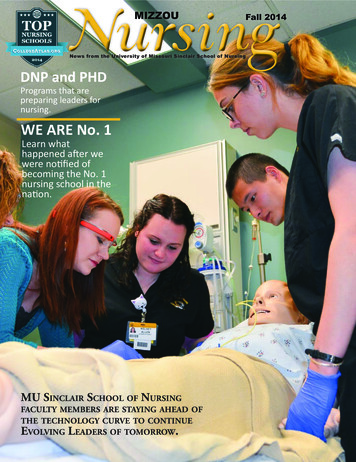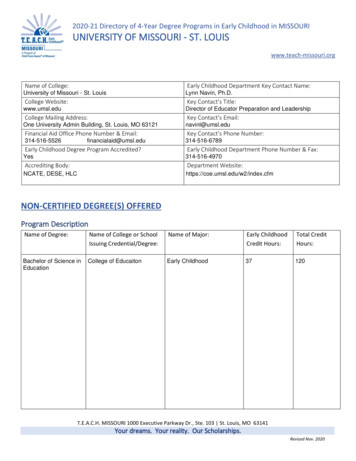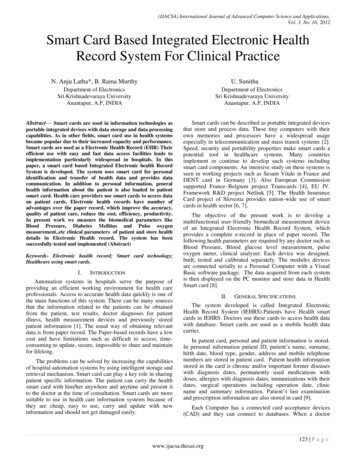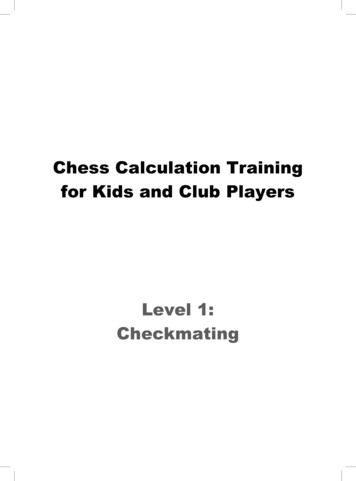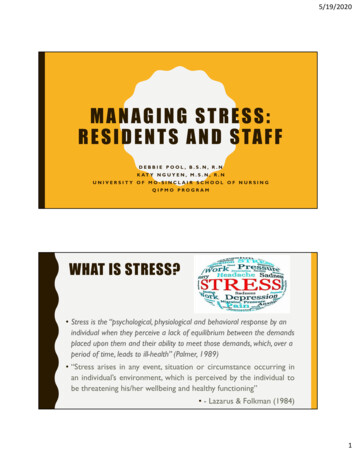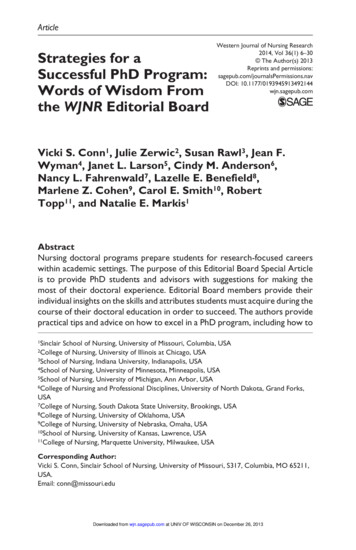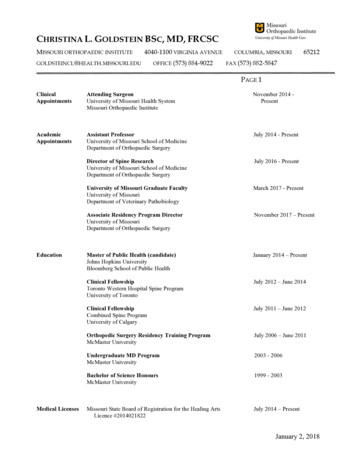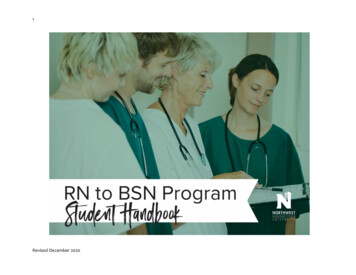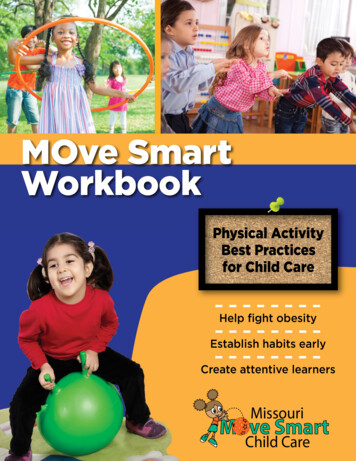
Transcription
MOve SmartWorkbookPhysical ActivityBest Practicesfor Child CareHelp fight obesityEstablish habits earlyCreate attentive learnersMissouriM ve SmartChild Care
“Physical fitness is not only one of the mostimportant keys to a healthy body, it is the basis ofdynamic and creative intellectual activity.”—John F. Kennedy
TABLE OF CONTENTSIntroduction. . . . . . . . . . . . . . . . . . . . . . . . . . . . . . . . . . . . . . . . . . . . . . . . . . . . . . . . . . . . . . . . . 2The Importance of Physical Activity in Early Childhood. . . . . . . . . . . . . . . . . . . . . . . . . . . . . . . . . . . . . . . . . 2Why MOve Smart Recognition?. . . . . . . . . . . . . . . . . . . . . . . . . . . . . . . . . . . . . . . . . . . . . . . . . . . . . . . . . . . . . . 3The Basics of MOve Smart Recognition. . . . . . . . . . . . . . . . . . . . . . . . . . . . . . . . . . . . . . . . . . . . . . . . . . . . . . . 3A Few Words About Infants . . . . . . . . . . . . . . . . . . . . . . . . . . . . . . . . . . . . . . . . . . . . . . . . . . . . . . . . . . . . . . . . 4What About Play Equipment?. . . . . . . . . . . . . . . . . . . . . . . . . . . . . . . . . . . . . . . . . . . . . . . . . . . . . . . . . . . . . . . 4MOve Smart Criteria Quick Reference. . . . . . . . . . . . . . . . . . . . . . . . . . . . . . . . . . . . . . . . . . . 5MOve Smart Best Practices. . . . . . . . . . . . . . . . . . . . . . . . . . . . . . . . . . . . . . . . . . . . . . . . . . . . 6#1Physical Activity Policy . . . . . . . . . . . . . . . . . . . . . . . . . . . . . . . . . . . . . . . . . . . . . . . . . . . . . . . . . . . . . . . 6#2Amount of Unstructured Physical Activity. . . . . . . . . . . . . . . . . . . . . . . . . . . . . . . . . . . . . . . . . . . . . . . 7#3Amount of Structured Physical Activity . . . . . . . . . . . . . . . . . . . . . . . . . . . . . . . . . . . . . . . . . . . . . . . . 8#4Staff Role Modeling. . . . . . . . . . . . . . . . . . . . . . . . . . . . . . . . . . . . . . . . . . . . . . . . . . . . . . . . . . . . . . . . . . . 9#5Staff Education and Training. . . . . . . . . . . . . . . . . . . . . . . . . . . . . . . . . . . . . . . . . . . . . . . . . . . . . . . . . . 10#6No Physical Activity Withheld. . . . . . . . . . . . . . . . . . . . . . . . . . . . . . . . . . . . . . . . . . . . . . . . . . . . . . . . . 11#7Indoor Play Space. . . . . . . . . . . . . . . . . . . . . . . . . . . . . . . . . . . . . . . . . . . . . . . . . . . . . . . . . . . . . . . . . . . . 12#8Outdoor Play Space. . . . . . . . . . . . . . . . . . . . . . . . . . . . . . . . . . . . . . . . . . . . . . . . . . . . . . . . . . . . . . . . . . 13#9Learning Integration. . . . . . . . . . . . . . . . . . . . . . . . . . . . . . . . . . . . . . . . . . . . . . . . . . . . . . . . . . . . . . . . . . 14#10Screen Time . . . . . . . . . . . . . . . . . . . . . . . . . . . . . . . . . . . . . . . . . . . . . . . . . . . . . . . . . . . . . . . . . . . . . . . . . 15#11Sedentary Time Limited. . . . . . . . . . . . . . . . . . . . . . . . . . . . . . . . . . . . . . . . . . . . . . . . . . . . . . . . . . . . . . . 16#12Visual Promotion of Physical Activity. . . . . . . . . . . . . . . . . . . . . . . . . . . . . . . . . . . . . . . . . . . . . . . . . . 17Glossary. . . . . . . . . . . . . . . . . . . . . . . . . . . . . . . . . . . . . . . . . . . . . . . . . . . . . . . . . . . . . . . . . . . 18Note: All terms defined in the glossary appear in bold orange text throughout the workbook.References. . . . . . . . . . . . . . . . . . . . . . . . . . . . . . . . . . . . . . . . . . . . . . . . . . . . . . . . . . . . . . . . . 18Appendices . . . . . . . . . . . . . . . . . . . . . . . . . . . . . . . . . . . . . . . . . . . . . . . . . . . . . . . . . . . . . . . . 19A. Physical Activity Self-Assessment . . . . . . . . . . . . . . . . . . . . . . . . . . . . . . . . . . . . . . . . . . . . . . . . . . . . . . . . 19B. Outdoor Activity and the Weather. . . . . . . . . . . . . . . . . . . . . . . . . . . . . . . . . . . . . . . . . . . . . . . . . . . . . . . . 21C. Managing and Leading Structured Activity: Teacher Tips for Success. . . . . . . . . . . . . . . . . . . . . . . 23D. Gross Motor Developmental Milestones: Quick Reference Chart. . . . . . . . . . . . . . . . . . . . . . . . . . . . 24E. Playground Stencils . . . . . . . . . . . . . . . . . . . . . . . . . . . . . . . . . . . . . . . . . . . . . . . . . . . . . . . . . . . . . . . . . . . . 26F. Books To Move To . . . . . . . . . . . . . . . . . . . . . . . . . . . . . . . . . . . . . . . . . . . . . . . . . . . . . . . . . . . . . . . . . . . . . 27MOve Smart: Best Practices for Child Care Providers1
INTRODUCTIONMOve Smart Child Care is a program that offers recognition for child care facilities that followbest practices in physical activity for young children. MOve Smart recognition is available for anyearly care and education facility including child care centers, Head Start sites, family child care homesand group homes.The Importance of Physical Activity in Early ChildhoodYoung children need opportunities to be active. They need to jump, run, dance and move theirbodies in a variety of ways.Baby steps are the first steps to fitness. Physical activity patterns develop in childhood andtend to last through adulthood.Physical activity is important for bodies. Active children have: More muscle strength. Better flexibility. Stronger bones. Healthier blood pressure. A healthier weight.Physical activity is also important for brains. There is a clear link between movement and learning.Exercise helps the brain to be ready, willing and able to learn.Research has shown that physical activity in children actually increases the number of brain cells andmakes important connections across the pathways in the brain. These connections are necessary forbrains to learn.Physical activity boosts blood flow all over the body, including tothe brain. Brain cells get better at connecting with each another. What’s theresult? Better thinking skills. Studies show that people who exercise moreare sharper mentally. The effects may be almost immediate. Onestudy found that school kids scored higher on math and readingcomprehension tests after exercising for 20 minutes. Better moods. Many studies have found that kids who exercise feelhappier. Physical activity releases brain chemicals that are naturalstress fighters. Sounder sleep. Kids who exercise regularly fall asleep faster than otherkids. They also stay asleep longer. The more vigorousthe activity, the bigger the sleep benefit. Getting enough sleep alsoimproves judgment and boosts memory.Early childhood is the time when children learn fundamental movement skills.These skills help children learn to move their bodies in different ways like jumping,running, twisting and throwing. When children are able to practice these skills between the ages oftwo and six, they are generally more successful in sports and active recreation as they grow older.2MOve Smart: Best Practices for Child Care Providers
Why MOve Smart Recognition?As a child care provider, you want to do what’s best for the children in your care. But how do youknow what’s best when it comes to physical activity? Missouri’s MOve Smart Criteria reflect whatexperts in the field of physical activity have determined to be best practices. This workbook not onlytells you what practices are best, but it also gives practical tips on how to make these practices a partof the child care program’s daily routine.Researchers found that average preschoolers were only getting about 25 minutes of moderate tovigorous physical activity during the child care day and they were sedentary for over half of theirday. A study also found that children’s levels of activity were very different from one preschool toanother. Are the children in one preschool really that different from the children in another? Probablynot. In fact, studies suggest that policies and practices put in place by caregivers have a greaterimpact on physical activity levels than facilities, space, budgets, teacher ratios or geography.In a survey of child care providers, the top reasons given for wanting to be a MOve Smart Child Careincluded:1. Increase awareness of the importance of physical activity for staff and families.2. Encourage staff and families to be more physically active.3. Market my child care program as a place that provides an active play environment.The Basics of MOve Smart Recognition Voluntary recognition for any child care program serving children frombirth through age five. Recognition is awarded by the Missouri Department of Health andSenior Services (DHSS). Two levels of recognition:77 Core — for meeting 6 core criteria.77 Advanced — for meeting the core criteria plus 6 additional criteria. Steps to becoming a MOve Smart Child Care:77 Complete the MOve Smart physical activity self-assessment withinput from key classroom staff. This is not required, but it mayshow what you are already doing well and what you may want towork on. Appendix A is the self-assessment form.77 Read the criteria and decide to apply for either the Core or Advanced level.77 Notify DHSS of your intention to become MOve Smart by sending an email to movesmart@health.mo.gov. This allows you to get support and resources that may be helpful.77 Make any changes in your policies and practices that are necessary to meet the criteria.77 Submit MOve Smart application along with the required documentation for each criteria.77 Receive MOve Smart recognition and celebrate with staff! Recognition includes:–– Certificate of achievement.–– MOve Smart window cling and poster.–– Permission to use the MOve Smart logo on your website and printed materials.–– A sample press release.–– Your child care program’s name listed on the DHSS website.–– Your MOve Smart status listed in the Child Care Aware provider search and in the HealthyChild Care newsletter.77 Child care providers are recognized for one year. You can renew by submitting a simpleself-assessment.MOve Smart: Best Practices for Child Care Providers3
A Few Words About InfantsThere are references to infants in several of the MOve Smart criteria. The first year of life is a time forinfants to explore, gain control over their bodies and make connections between the brain and muscles.Active time with infants should be one-on-one and not overly structured. You can help with theirdevelopment by following these recommendations: Offer short periods of supervised tummy time several times a day until the infant starts creeping orcrawling. Start with 3–5 minutes and gradually increase the time as the infant enjoys it. Get down on the floor during tummy time, face to face to engage the infant through talking,singing and smiling. Take infants outdoors 2–3 times a day as tolerated. Provide large, open, safe play surfaces to promote free movement and development of skills suchas rolling, sitting, crawling and kicking. Place rattles, balls and other toys nearby to encourage reaching and grasping. Limit time in confining equipment such as swings, bouncy chairs and strollers. No more than 15minutes at a time while the infant is awake.What About Play Equipment?Children can be active with or without toys or play equipment. Creative games can be played usingsimple items like pool noodles, scarves, rolled up socks and laundry baskets. MOve Smart ChildCare does not require that you purchase any specific play equipment, however when you do buyequipment, here are some things to consider.1. Children tend to be more active with portable play equipment like balls and tricycles than theyare with the more expensive fixed playground equipment like climbing structures.2. Different types of toys help children develop different kinds of movement skills, so offer a varietyof items for children to play with. Try to have some items from each of these categories: Riding and push-pull toys such as tricycles, dump trucks, wagons and scooters. Throwing, catching and striking toys such as bean bags, pom poms, pool noodles, plastic bats,targets and a variety of balls. Provide sturdy, durable balls for outdoor play and soft, easy tograsp balls for indoor play and for younger children. Twirling toys such as ribbons, scarves, batons and parachutes. Balance toys such as balance beams, stepping stones and rocking toys. Crawling, tumbling and climbing equipment such as mats, tunnels, ladders and big blocks. Jumping toys such as jumping balls, ropes, hoops, small hurdles and hopscotch grids.3. Stencils for painting hopscotch and other designs on playgrounds are available to borrow fromMissouri MOve Smart. See appendix D for more information.4. No child should be left out of active play, so make sure there is enough equipment for all childrenin the group to participate at the same time.5. Buy good quality, durable play equipment so you don’t have to replace it often. Paying a littlemore up front may cost less in the long run.The MOve Smart application and information on training opportunities andother resources can be found at www.health.mo.gov/movesmart.4MOve Smart: Best Practices for Child Care Providers
MOve Smart Criteria Quick ReferenceRequirementBest PracticePhysical Activity PolicyA written policy exists that addressesthe facility’s physical activity practices.This policy is communicated to staff andparents.2Amount of UnstructuredPhysical ActivityProvide at least 60 minutes ofunstructured physical activity each dayfor toddlers and preschoolers.3Amount of StructuredPhysical ActivityProvide at least 30 minutes of teacherled structured physical activity each dayfor toddlers and preschoolers.Staff Role ModelingStaff promote and participate inchildren’s active play.Staff Education andTrainingEach staff person completes a one hourtraining about the MOve Smart ChildCare program.No Physical ActivityWithheldPhysical activity is never withheld aspunishment.Indoor Play SpaceThe facility has indoor space that allowsfor moderate to vigorous physicalactivity.Outdoor Play SpaceThe facility has an outdoor play areathat encourages active play.Learning IntegrationRoutinely incorporate structuredphysical activity in learning activities atleast two times each day.Screen TimeLimit screen time to 30 minutes perweek. The 30 minutes of screen timeshould be used for educational orphysical activity purposes only. Noscreen time for children under 2 yearsof age.Sedentary Time LimitedChildren are not kept sedentary formore than 30 minutes at a time exceptduring naps and meals.Visual Promotion ofPhysical ActivityPictures, posters, books and other visualmaterials promote physical activity.1CORE LEVELRecognitionRequirements(Criteria 1–6are required forCore uirements(All 12 criteriaare required forAdvanced LevelRecognition)Criteria101112MOve Smart: Best Practices for Child Care Providers5
ADVANCEDCORE LEVELLEVELPhysical Activity Policy1A written policy exists that addresses the facility’sphysical activity practices. This policy is communicatedto staff and parents.WhyA physical activity policy is a set of written statements that define and makepermanent your day-to-day practices. It sets the standards for what your childcare program believes in and does. The policy is a communication tool that helpsparents, staff and children know what is expected. It leads to more consistentpractices between classrooms and among staff members.How to Do It Start small with a few practices that you already do and put them in writing. TheMOve Smart criteria can be your guide. Get input from staff and parents before you set a policy. It’s important for themto be supportive. Keep it simple. Say only what you really do or plan to do. Otherwise, it won’tmean anything. Print policy in employee handbook and use it when hiring and training staff. Makesure all staff know that they are expected to follow the policy. Review the policy at least once a year to make sure it is still working. Revise it ifyou need to. Watch what employees are doing to make sure policy is being followed. Tell parents about the policy to show that you value active play! The familyhandbook or welcome packet is a good place to print your policy. Make sure thepolicy includes things that parents can do to make it work, like dressing childrenappropriately for outdoor play.Sample PolicyStatementsPolicy should cover all of the MOve Smart criteria that your facility follows. Thisworkbook lists sample policy statements under most criteria. The wording can bechanged to fit your needs and make it your own.How toDocumentSubmit a copy of your physical activity policy as it is written in your employee andparent handbooks.Get input from staff andparents before you set apolicy. It’s important forthem to be supportive.6MOve Smart: Best Practices for Child Care Providers
ADVANCEDCORE LEVELLEVELAmount of Unstructured Physical Activity2Provide at least 60 minutes of unstructured physical activityeach day for toddlers and preschoolers.WhyFree play helps develop a child’s imagination, creativity, body awareness and senseof space and dimension. Children learn about the world by moving around in it.How to Do It Provide a safe space that is large enough for children to move freely. Provide a variety of age-appropriate portable play equipment, which encouragesmore vigorous activity than fixed play equipment. Children tend to move more and play harder when they are outside. Scheduleat least 60 minutes of outdoor play per day. Make fresh water available andencourage children to drink water. During free play, children may not be as active as you think. Ten minutes at atime may result in higher levels of activity than one long period. Allow severalshort periods of activity throughout the day. Plan for all kinds of weather. See weather chart in Appendix B. If extreme weatherdoes not allow for outdoor play, increase the amount of activity indoors. Ask parents to dress their children for outdoor play in both hot and coldtemperatures. Hats, gloves and warm coats are essential in winter. If somechildren don’t have these, you might consider starting a collection of donatedouterwear. Shoes should allow children to run easily and safely.ActivityExamples forInfants Supervised tummy time. Crawling through tunnels. Reaching for a toy.ActivityExamples forToddlers Chasing bubbles.Digging in a sandbox.Pushing and pulling toys.Provide mats and pillows on floor to encourage safe jumping and rolling.ActivityExamples forPreschoolers Playing tag or hide and seek.Climbing on equipment and jumping off.Throwing and catching balls.Riding trikes.Sample PolicyStatements Children are allowed at least 60 minutes of unstructured free play daily. Children have outdoor active playtime at least two times daily, weatherpermitting.How toDocumentSubmit a daily schedule for each age group highlighting when children haveunstructured active play time. Also list three examples of unstructured activitiesthat each age group does.MOve Smart: Best Practices for Child Care Providers7
ADVANCEDCORE LEVELLEVELAmount of Structured Physical Activity3Provide at least 30 minutes of teacher led structured physicalactivity each day for toddlers and preschoolers.WhyStructured physical activity helps children learn and improve fundamentalmovement skills and promotes social interaction with adults and peers. Childrenwho get structured activity tend to be more active during free play time.How to Do It Structured activities have a specific purpose and clear goals for the children.They usually encourage moderate to vigorous physical activity. Plan a variety of teacher led activities throughout the day and write them intothe daily schedule. Five to ten minutes at a time is enough, especially for youngerchildren. Transition times are an easy way to incorporate simple, structured activities. After the children have been on the playground for ten or fifteen minutes and arestarting to slow down in their free play, lead a structured activity to encouragemore moderate to vigorous physical activity. Activities should allow all children to play at the same time without taking turns.Modify difficulty as needed to make them easier or more challenging for childrenwith different skill levels. Avoid elimination games. Train staff in how to lead and manage structured physical activity. There are manyresources available with instructions for structured activities. Refer to Appendix Cfor more information on managing and leading structured physical activity.ActivityExamples forInfants Games such as pat-a-cake and peek-a-boo.Encourage reaching and scooting to get to toys.Provide objects of different size, texture, color and shape.Assist with sitting, crawling, standing and stepping when infant is ready.ActivityExamples forToddlers Make an obstacle course to encourage crawling, climbing and walking.Kick and chase a large ball.Find and quickly gather soft objects hidden throughout the play area.Follow songs that promote movement.ActivityExamples forPreschoolers Move like different animals. Act out a storybook. See appendix F for book suggestions. Play games such as Simon Says or Follow the Leader. Choose actions like runningin place and jumping.Sample PolicyStatements Teacher led movement activities are provided for at least 30 minutes daily. Thisactivity is split into several smaller segments throughout the day.How toDocumentSubmit a daily schedule for each age group highlighting when structured physicalactivity is led. Also list three examples of structured activities that are done witheach age group.Tip for Success: Choose activities that are cooperative, notcompetitive. Young children may not handle competitionwell. They are all winners; no one should lose.8MOve Smart: Best Practices for Child Care Providers
ADVANCEDCORE LEVELLEVELStaff Role Modeling4Staff promote and participate in children’s active play.WhyChild care staff play an important role in modeling and promoting physical activity.Staff enthusiasm and encouragement efforts to promote physical activity canincrease children’s activity levels. A caregiver’s negative attitude about physicalactivity can lead to less active children. Children tend to mirror or imitate theactivity or inactivity that they see in staff. As an added benefit to staff, being moreactive will result in increased energy, reduced stress and overall better health.How to Do It When hiring new staff, make it known that they are expected to be physicallyactive with the children. As such, encourage staff to wear comfortable shoes andclothing for easy and safe movement. Provide training and support to encourage staff to be active. As they see positivechanges in themselves, they will be enthusiastic role models. Encourage staff to move around instead of sitting on the playground. Recognizephysical limitations of any staff members and offer alternative ways for them toparticipate. Ask all staff to participate in daily structured physical activity with the children.Choose activities that staff can enjoy and have fun with. Focus on success. Smile, give children positive feedback and encouragingcomments when learning new skills. Children are more willing to try somethingwhen they can succeed. Talk to parents and share activities that families can do at home.Examples Organize a walking challenge for staff. Give a staff award for “Motivational Mover and Shaker of the Month.” Use coaching comments like “Nice job looking at the ball and catching it!”, “Youmust be strong to lift that!” and “I’m so proud of you for trying!”Sample PolicyStatements For employee handbook: Staff must come to work dressed appropriately forphysical activity. Teachers are expected to participate in activities along with thechildren. For parent handbook: Our staff encourage children to be active and regularly joinchildren in active play.How toDocumentSubmit a copy of the policy addressing staff participation and role modeling.Discuss and give examples of how staff participate and role model physical activity.Tip for Success: Identify a MOve Smart champion.This would be a staff person who is energetic andenthused about physical activity. It’s someone whocan motivate and lead the way for other staff.MOve Smart: Best Practices for Child Care Providers9
ADVANCEDCORE LEVELLEVELStaff Education and Training5Each staff person completes a one hour training about theMOve Smart Child Care program.WhyIt is important that all staff have an understanding of the MOve Smart criteria.Completion of this training by all staff will help to ensure more consistentimplementation of the MOve Smart criteria. Training increases staff’s comfort levelin leading and taking part in physical activity.How to Do It Have staff complete the online training module on Move Smart Child Care atwww.health.mo.gov/movesmart. This module is approved for one clock hour.Or Have staff attend a face-to-face training on MOve Smart. These trainings may beoffered through child care health consultants, University of Missouri Extension, orChild Care Aware, but are not available in all areas. Other trainings on physical activity may be approved upon request. Trainingshould include at a minimum, the following topics:––Importance of physical activity in early childhood.––Recommended amounts of daily physical activity for young children.––How to effectively encourage, lead and incorporate physical activity throughoutthe day. Training should be completed by new staff within three months of employment.Sample PolicyStatementsAll staff receive training on developmentally appropriate physical activity practices.How toDocumentSubmit the names of all staff who completed the training. DHSS will verifyattendance for all clock hour approved trainings.Tip for Success:Make physical activity fun!Encourage staff to laughand act silly with the kids.10MOve Smart: Best Practices for Child Care Providers
ADVANCEDCORE LEVELLEVELNo Physical Activity Withheld6WhyPhysical activity is never withheld as punishment.Children should experience physical activity as something positive. It should not beassociated with punishment in any way. When children enjoy physical activity, theyare more likely to stay active as adults.Withholding activity may actually make a child’s behavior worse. Oftentimes,children become disruptive when they have extra energy. They need to be allowedto burn off that energy through active play. Making the child sit inside while othersgo out to play does not allow the child to use their “extra energy.”How to Do It Adopt policy to prohibit staff from restricting active play time as a consequence formisbehavior (except when the child’s behavior is dangerous to himself or others). If a child must be removed from group activities for safety reasons, try to offer analternative physical activity such as walking or punching a soft item. Provide training for staff on positive behavior management for children.Sample PolicyStatementAt our center, teachers use positive behavior support. We believe that misbehaviorin children is an opportunity to teach correct behavior. Active play will not bewithheld as a consequence for misbehavior. We will re-direct children to safephysical activities. If children are out of control, they may be placed in timeout forno longer than one minute per age of the child.How toDocumentSubmit the facility’s written policy regarding the practice of not withholdingphysical activity as punishment.When children enjoyphysical activity, theyare more likely tostay active as adults.MOve Smart: Best Practices for Child Care Providers11
ADVANCED LEVELIndoor Play Space7The facility has indoor space that allows for moderate tovigorous physical activity.WhyAn indoor area that supports movement provides opportunities for creative andspontaneous activity throughout the day. It allows for physical activity criteria to bemet on days when weather prohibits outdoor play.How to Do It Many structured physical activities are controlled enough for small indoor areas.A separate room or area for active play is ideal, but may not be realistic for manyfacilities. Create space for active play by moving furniture out of the way and usingstorage boxes, baskets or plastic containers to free up floor space. Secure itemsthat cannot be moved, could be broken or may cause harm to children duringactive play. Create boundaries and teach children where they are allowed to be active. Usecarpet squares or poly spots to define each child’s personal space. Provide a variety of play materials like scarves, bean bags, soft balls and musicalinstruments that promote physical activity indoors. Make a variety of toys available that encourage active play. Rotate the toys sochildren don’t become bored with them.Examples Create obstacle courses. Ask the children to help design a course. Use a hallway as a bowling alley if there is no other traffic in the hall. Play “Move and Freeze.” Challenge children to see how fast they can move ontheir own floor spot then freeze on command.How toDocumentSubmit at least one photo and description of space that is used for indoor physicalactivity.Tip for Success: Whetherindoor or outdoor, the goalis to keep children active.Don’t limit your creativityin planning and preparationso that your children canengage in mentally andphysically challenging play.12MOve Smart: Best Practices for Child Care Providers
ADVANCED LEVELOutdoor Play Space8The facility has an outdoor play area that
4 MOve Smart: Best Practices for Child Care Providers MOve Smart: Best Practices for Child Care Providers 5 A Few Words About Infants There are references to infants in several of the MOve Smart criteria. The first year of life is a time for infants to explore, gain control over their b
